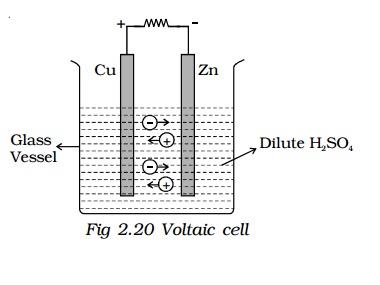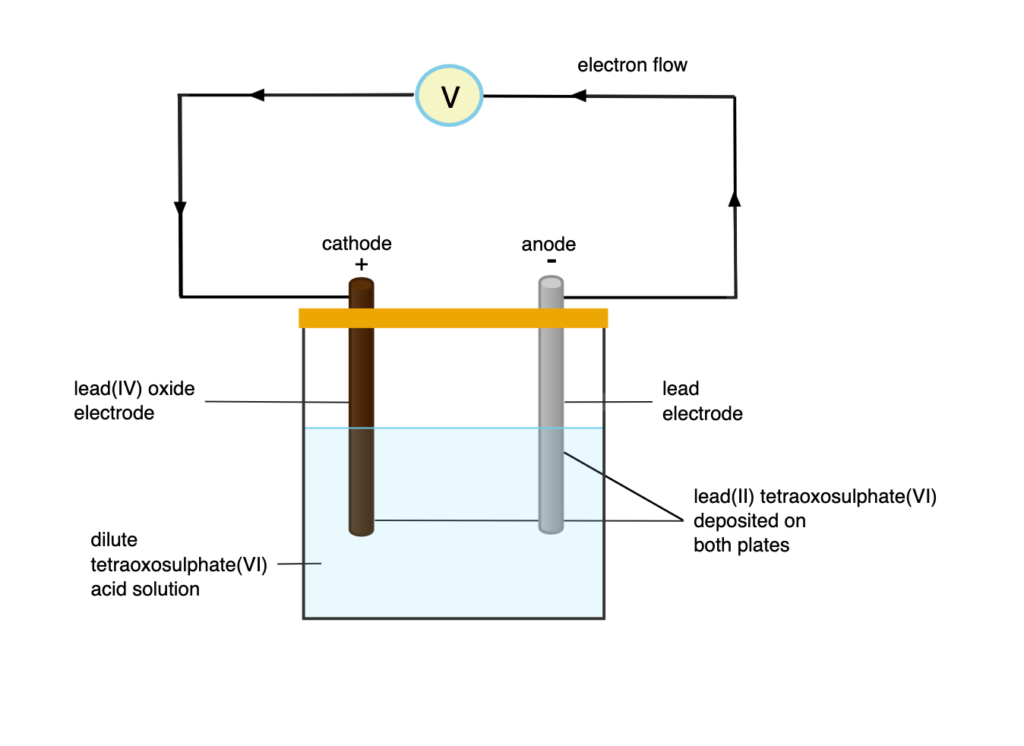Electrochemical Cell
An electrochemical cell is a device that converts chemical energy into electrical energy through redox reactions occurring within it.
Cell Notation
- The anode half-cell is written first, followed by the cathode half-cell.
- A single vertical line (
|) separates different phases in contact (e.g., solid and aqueous). - A double vertical line (
//) represents a salt bridge or porous barrier between the two half-cells. - Each chemical's phase is noted in parentheses: (s), (l), (g), or (aq).
Standard Electrode Potential, \( E^\circ \)
The standard electrode potential of a metal/ion system is the potential difference between a metal electrode and a 1 M solution of its ions at 25°C. The standard hydrogen electrode (SHE) is assigned a potential of 0.00 V for reference.
Electrode potentials vary with:
- Overall energy change of the reaction
- Ion concentration in solution
- Temperature
Calculating the Cell Potential, \( E^\circ_{\text{cell}} \)
The standard cell potential can be calculated using:
\( E^\circ_{\text{cell}} = E^\circ_{\text{cathode}} - E^\circ_{\text{anode}} \)
Example:
Problem: Determine the standard cell potential for a voltaic cell composed of Ag/Ag⁺ and Sn/Sn²⁺ half-cells.
Given:
- \( E^\circ_{\text{Ag}} = +0.80 \, \text{V} \)
- \( E^\circ_{\text{Sn}} = -0.14 \, \text{V} \)
Step 1: Identify the half-reactions
- Oxidation (anode): Sn(s) → Sn²⁺(aq) + 2e⁻
- Reduction (cathode): Ag⁺(aq) + e⁻ → Ag(s)
Step 2: Balance and write the overall redox equation:
Sn(s) + 2Ag⁺(aq) → Sn²⁺(aq) + 2Ag(s)
Step 3: Calculate \( E^\circ_{\text{cell}} \):
\( E^\circ_{\text{cell}} = +0.80 \, \text{V} - (-0.14 \, \text{V}) = +0.94 \, \text{V} \)
Conclusion: The positive cell potential indicates a spontaneous redox reaction. Note that the potential for Ag⁺ is not multiplied by 2, even though the half-equation is doubled to balance the reaction.
Types of Electrochemical Cells
- Primary Cells:
These are non-rechargeable cells where the redox reactions are irreversible. Once the reactants are depleted, the cell can no longer generate electricity.
Examples: Daniel cell, Leclanché cell (dry cell)
- Secondary Cells:
These are rechargeable cells. The redox reactions are reversible, allowing the cell to act as both a galvanic and electrolytic cell.
Example: Lead-acid accumulator
The Simple Primary Cell (Voltaic Cell)
A simple cell is created by placing two different metal electrodes in an electrolyte. Wires are then connected to these metals and attached to a voltmeter, which measures the potential difference in the circuit. If a deflection is observed on the voltmeter, the cell generates voltage. A rightward deflection indicates that the electrode connected to the positive terminal of the voltmeter is the anode (positive electrode), while the one connected to the negative terminal is the cathode (negative electrode). If the deflection is to the left, the connections should be reversed.
The simple cell or voltaic cell consists of two electrodes, one of copper and the other of zinc dipped in a solution of dilute sulphuric acid in a glass vessel. The copper electrode is the positive pole or copper rod of the cell and zinc is the negative pole or zinc rod of the cell. The electrolyte is dilute sulphuric acid.
 Credit: BrainKart
Credit: BrainKart
Defects of a Simple Cell
1. Polarization
Polarization occurs when hydrogen bubbles form on the positive electrode, insulating it and reducing the efficiency of the cell. This defect slows down and eventually stops the operation of the cell. It can be corrected by:
- Occasionally brushing the plates (though this is inconvenient).
- Using a depolarizer, such as manganese dioxide, which oxidizes hydrogen and removes the bubbles.
2. Local Action
Local action occurs when impure zinc is used, leading to gradual corrosion of the zinc plates. This can be prevented by:
- Cleaning the zinc with sulfuric acid (H2SO4).
- Rubbing the zinc with mercury, which forms an amalgam that covers impurities and prevents unwanted reactions with the electrolyte.
Leclanché Cell
Leclanché cells are classified into two types: wet and dry. The wet Leclanché cell consists of a zinc rod acting as the cathode, immersed in an ammonium chloride solution within a glass container. The anode is a carbon rod enclosed in a porous pot, surrounded by manganese dioxide, which serves as a depolarizer.
An electromotive force (e.m.f) is generated by the interaction between zinc, carbon, and the electrolyte, causing current to flow from the zinc electrode to the carbon electrode within the cell. Externally, the current moves from carbon to zinc.
The e.m.f of a Leclanché cell is approximately 1.5 volts. However, one major drawback is polarization, which occurs when hydrogen bubbles accumulate on the carbon electrode, reducing efficiency. This issue can be mitigated by allowing the cell to rest periodically. Additionally, the wet Leclanché cell is unsuitable for portable use due to the risk of spillage.
 Credit: PhysicsMax
Credit: PhysicsMax
Dry Leclanché Cell
To overcome portability issues, the dry Leclanché cell was developed. Here, the ammonium chloride electrolyte is in a jelly-like paste rather than a liquid solution. The carbon rod, acting as the positive electrode, is surrounded by a mix of manganese dioxide and powdered carbon inside a zinc container, which serves as the negative electrode.
Dry cells are lightweight and easy to transport, making them ideal for use in devices such as flashlights and transistor radios. However, they deteriorate over time due to local action.
Daniel Cell
The Daniel cell was invented to address the issue of polarization. It consists of a zinc rod as the negative electrode and a copper container as the positive electrode. The electrolyte is a dilute sulfuric acid solution contained within a porous pot around the zinc rod, while the depolarizer is copper sulfate solution in the surrounding copper container.
The Daniel cell provides a more stable e.m.f of approximately 1.08 volts, making it more reliable than the Leclanché cell.
 Credit: BrainKart
Credit: BrainKart
Secondary Cells
Secondary cells can be recharged after use. The two main types are:
- Lead-acid accumulator
- Alkaline (NiFe) accumulator
Lead-Acid Accumulator
This is the most common type of secondary cell. It consists of lead oxide as the positive electrode, lead as the negative electrode, and sulfuric acid as the electrolyte. During discharge, the plates gradually convert to lead sulfate, and the acid becomes diluted. A fully charged cell has an e.m.f of 2.2V and a relative density of 1.25. When discharged, the values drop below 2.0V and 1.15, respectively.
 Credit: Kofastudy
Credit: Kofastudy
Maintenance of Lead-Acid Accumulators
- Maintain electrolyte levels with distilled water.
- Recharge the cell when the acid density falls below 1.15; it is fully charged at 1.25.
- If unused for long periods, discharge occasionally or remove the acid and store the cell dry.
- Keep the battery clean to prevent current leakage.
Alkaline (NiFe) Accumulator
The NiFe accumulator is named after its primary elements: nickel (Ni) and iron (Fe). The positive electrode is made of nickel hydroxide, while the negative electrode is composed of iron or cadmium. The electrolyte is potassium hydroxide dissolved in water.
These cells last longer, retain charge better than lead-acid accumulators, and require minimal maintenance. They are commonly used in factories and hospitals for emergency power supplies. However, they are bulkier, more expensive, and have a lower e.m.f of approximately 1.25V.
Difference Between Electrolytic and Electrochemical Cells
| Electrochemical (Galvanic/Voltaic) Cell | Electrolytic Cell |
|---|---|
| Chemical energy is converted into electrical energy. | Electrical energy is converted into chemical energy. |
| Redox reactions are spontaneous. | Redox reactions are non-spontaneous and require external energy. |
| Anode is negative; cathode is positive. | Anode is positive; cathode is negative. |
| Electrons are released by the species undergoing oxidation. | Electrons come from an external power source (e.g., battery). |